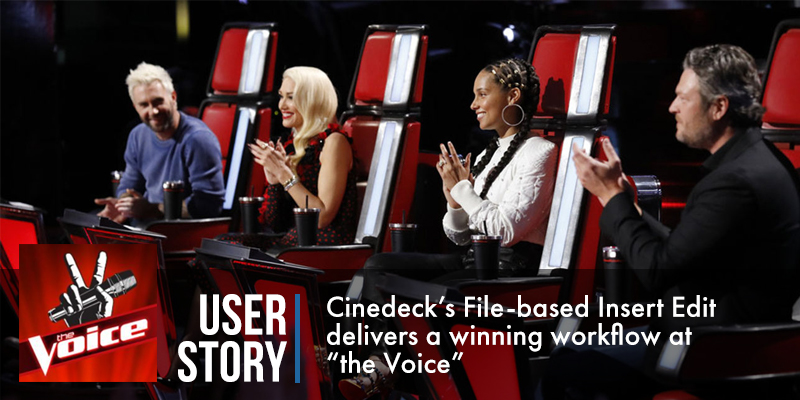Cinedeck’s File-based Insert Edit delivers a winning workflow at “the Voice”
Since 2015 Cinedeck has been integral to the delivery of every episode for NBC’s hit show “the Voice” – nearly 100 episodes and counting! The editorial team count on Cinedeck’s Insert-Edit capability to deliver shows on time and on budget week after week.
With two 2hr episodes to deliver each week, the post-production team faces an enormous time crunch that Cinedeck now helps to solve. Prior to Cinedeck, the Voice was using SRWs and tape that needed to be shuttled from editorial, audio, and finishing. With Cinedeck, they’ve been able to eliminate media costs associated with tape as well as dramatically cut down on the number of times media needs to be re-encoded and re-QC’d.
Jim Sterling and Robert M. Malachowski, Jr., ACE of the “the Voice” discuss how Cinedeck’s File-based Insert Edit helped them migrate from a tape-based workflow, enabling an end-to-end file-based solution. Find out how this highly rated Emmy award-winning network show, with tight delivery schedules and multiple distributions & promotional requirements, has dramatically changed and benefited from File-based Insert Edit in their post workflow.
- Laying off the Video Master

Three editors lay off their segments as they are completed to a pre-blacked ProRes file with 12 channels of scratch audio. Once the last editor inserts their segment, the file is ready to go, without exporting, to the Voice’s audio house for a live sweetening session. - Live Audio Mix

Using Pro Tools and a 2nd Cinedeck, the audio editor punches in a live audio mix to the master video file – laying off tracks of audio as they are completed to the master file. Once the audio sweetening is completed, the file goes to the finishing house. - Insert Edit and Final Changes

If there is a fix that needs to be made to an audio track or a frame of video, the Voice sends patches to the finishing house instead of re sending the entire file. And on a 3rd Cinedeck, the finishing house completes the inserts without having to re-encode and re-QC the entire file. At every step of the post process, the master file is being worked on which means there are no unnecessary duplicates or costs associated with iteratively re-exporting for every fix. - Mastering and Versioning

The final file is QC’d and multiple delivery versions are created for both domestic and international distribution.

